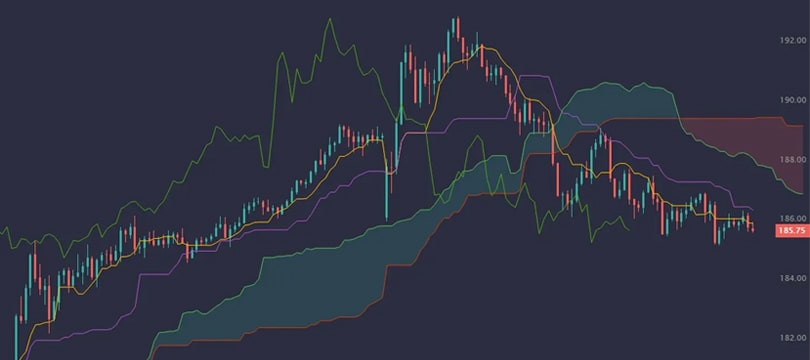In the world of online trading, technical analysis plays a fundamental role in providing investors with the tools to navigate the often turbulent waters of financial markets.
Among the many techniques and indicators available,
the Ichimoku Cloud emerges as one of the most complex and, at the same time, effective tools, appreciated by both beginner and more experienced traders.
In the following guide, we discuss the Ichimoku Cloud, explaining what it is, how it is calculated, and how it can be used to improve trading strategies.
Ichimoku Cloud: Definition and Calculation
The Ichimoku Cloud, also known as Ichimoku Kinko Hyo or Ichimoku Cloud, is a technical analysis indicator that provides information on support and resistance levels, trend direction, and momentum, all in a single view that aims to capture the market "overview."
Developed in the 1930s by Japanese journalist Goichi Hosoda, the Ichimoku Cloud has only become globally popular in recent decades.
The indicator consists of five main lines that intertwine and overlap on a price chart, creating the "cloud" that gives the indicator its name. These lines are:
- Tenkan-sen (Conversion Line), which represents the average of the highest and lowest prices of the last 9 periods.
- Kijun-sen (Base Line), similar to Tenkan-sen, but calculated on the prices of the last 26 periods.
- Senkou Span A (Leading Span A), the average of Tenkan-sen and Kijun-sen, projected 26 periods into the future.
- Senkou Span B (Leading Span B), which represents the average of the highest and lowest prices of the last 52 periods, also projected 26 periods into the future.
- Chikou Span (Lagging Span), which is the current closing price projected 26 periods into the past.
The "cloud" is formed by the area between Senkou Span A and Senkou Span B. The color of the cloud varies based on the relative position of these two lines, providing an immediate visual on market sentiment: a green cloud indicates an uptrend, while a red cloud suggests a downtrend.
How to Leverage the Ichimoku Cloud
The Ichimoku Cloud offers various usage modes, making it very versatile. Here are some of the main usage strategies:
- Trend Identification. A simple way to determine the market trend is to observe the price position relative to the cloud. If the price is above the cloud, the trend is considered bullish; if it is below, bearish.
- Trading Signals. Crossovers between Tenkan-sen and Kijun-sen often indicate potential entry or exit points. A bullish crossover (Tenkan-sen crossing above Kijun-sen) can be a buy signal, while a bearish crossover suggests a sell.
- Support and Resistance Levels. The cloud itself acts as a dynamic support or resistance zone. A price entering the cloud may indicate market indecision, while the price emerging from one side of the cloud can signal a trend continuation or reversal.
Which Asset Classes are Best Suited for the Ichimoku Cloud?
The Ichimoku Cloud is an extremely versatile technical analysis indicator, suitable for various asset classes, including stocks, currencies (Forex), cryptocurrencies, commodities, and market indices.
Its effectiveness is not limited to a particular type of market but depends more on the volatility and trend of the asset in question.
However, it is particularly well-suited
to markets with strong trends, as its components are designed to identify and confirm trends, as well as provide dynamic support and resistance levels.
For example,
in Forex, where the market is known for its strong trends and high liquidity, the Ichimoku Cloud can be particularly useful for capturing significant price movements. Similarly, in cryptocurrency trading, known for its high volatility, it can help ride rapid price movements and identify potential entry and exit points.
The Right Psychological Approach to Using Ichimoku
The effectiveness of the Ichimoku Cloud depends not only on its correct interpretation but also on the psychological approach with which it is used. Here are some tips to maximize the benefits of this tool.
Practice patience. Given the complexity of the indicator and the time required to assimilate its signals, it is essential to approach it with patience, dedicating time to study and practice.
Maintain discipline. Following the signals provided by Ichimoku requires discipline, avoiding being guided by emotions such as fear or greed.
Risk management. As with any trading tool, it is crucial to establish one's risk limits in advance, using stop-losses and taking positions proportional to one's portfolio.




